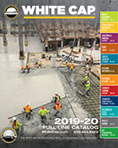How To Choose The Right Ladder
What are the main types of work ladders available?
Step Ladders
These are the most common ladders in use on jobsites today. They’re the leading choice because they don’t have to be leaned against a building or any other kind of support. Between the two types of step ladders (front-step and twin-step) the twin-step is the most popular because it has weight-supporting, climbable rungs on both sides. Don’t ever climb a closed step ladder.
Extension Ladders
Reaching high places is the main benefit with this ladder type, but it must be leaned against stable support before use. The typical extension ladder has two parts: the base – that remains on the ground and the sliding, movable fly – that gives the ladder its ability to reach higher. Make sure to not place the base of an extension ladder too close to the building that is supporting it.
Platform Or Podium Ladders
These are front-step ladders with a platform on the top step that typically has a guardrail to make standing at the top as comfortable and safe as standing on the ground. Platform ladders give users the ability to work overhead and rotate 360 degrees while working without ever having to get down and move the ladder. Be sure to resist the urge to over-reach because you feel safer with the guardrail.
Telescoping Ladders
This type of ladder is a relative newcomer designed to be height-adjustable like traditional extension ladders. The big difference is they use nested sections that slide in and out of each other and lock into place. Unlike the traditional extension ladder, individual sections slide together to create a size that’s easily carried by one person. And just like the traditional extension ladder, be sure the base is the right distance from its supporting wall.
What is the right length ladder to provide a safe reaching height?
The highest level rung you should ever stand on with a step ladder is two steps below the top. Any higher and you risk losing your balance and taking a fall. And the rule of thumb to determine your maximum reaching height is to add four feet to the height of the ladder. You never want to stretch or reach out to the side. Get down and move the ladder instead.
What Type and Duty Rating (weight support) do I need?
It’s not just about how much you weigh by yourself. When you’re deciding on the ladder performance rating you that’s right for you, be sure to think about who else will be using it. Another thing that many ladder buyers overlook is including the weight of items you’ll be wearing and things you’ll be carrying up the ladder with you. A good example is a five-gallon bucket of paint weighs about 60 pounds. And don’t forget that your tools aren’t weightless either. Here are the standard Types and Duty Ratings:
Type IAA (Extra Heavy Duty)
375 pounds
Type IA (Extra Heavy Duty)
300 pounds
Type I (Heavy Duty)
250 pounds
Type II (Medium Duty)
225 pounds
Type III (Light Duty)
200 pounds
Is there a special type of ladder to use when working around electricity?
Lightweight aluminum ladders are great for most jobs, but when you’re working with or around a lot of electrical work or electricity in general, you’re going to want your ladder to be made with non-conducting material. Fiberglass is a good choice since it answers the non-conducting issue but still gives you strength without being too heavy.
![]()
Check out these links for more information on ladders and how to use them:
American Ladder Institute / Ladders101
www.ehstoday.com / Ladder Safety / American Ladder Institute president Ryan Moss




